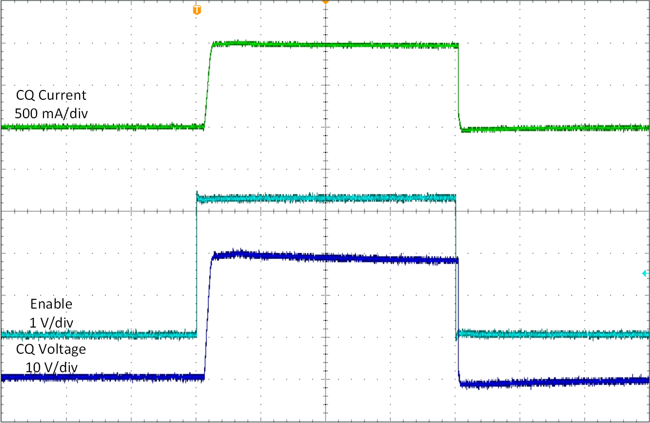TIDUEB8C July 2018 – March 2021 TPS274160
- Description
- Resources
- Features
- Applications
- 5
- 1System Description
- 2System Overview
- 3Hardware, Software, Testing Requirements, and Test Results
- 4Design Files
- 5Software Files
- 6Related Documentation
- 7About the Author
- 8Revision History
2.3.1 IO-Link PHY
The TIOL111 device used here has the main purpose to shift levels between the 3.3-V logic side and the 24-V interface. The optional internal LDO, the wake up detection and overcurrent detection is not used.
However, the TIOL111 device in master configuration has to be able to drive an IO-Link conform wake-up pulse. IO-Link devices start up in SIO mode and have to be configured to IO-Link prior to communication. So, the output is either on a low (around 0 V) or high level (around 24 V) and is driven. To switch the mode, the master has to send a pulse of 80-µs length and must be able to drive 500 mA during this pulse and still reach a certain voltage. The device will switch to IO-Link mode after detection of this pulse and communication can begin.
The exact parameters for testing this are listed in the IO-Link® Test Specification, Version 1.1.2, see Table 2-1 and Table 2-2. Both parts of the specification have to be met to be compliant.
| TEST CASE ATTRIBUTES | IDENTIFICATION, REFERENCE |
|---|---|
| Identification (ID) | SDCI_TC_0021 |
| Name | TCM_PHYL_INTF_IQWUH |
| Purpose (short) | Driver capability of the wake-up pulse – high-side driver |
| Equipment under test (EUT) | Master and Legacy Master |
| Test case version | 1.0 |
| Category, type | Master protocol test; test to pass (positive testing) |
| Specification (clause) | See Section 5.3.3.3, Table 9 of IO-Link Interface and System Specification Version 1.1.22 |
| Configuration, setup | – |
| TEST CASE | CONDITIONS, PERFORMANCE |
| Purpose (detailed) | The Master shall drive the resistive load above the threshold high level of a receiver. Measure pulse voltage at Master C/Q port with Master configured for SDCI. The pulse voltage is measured with a resistive load applied between C/Q and L–. |
| Precondition | Master configured to SDCI mode |
| Procedure | a) Apply minimum supply voltage (VSM = 20 V) to Master b) Apply resistive load Rload between C/Q and L–: Rload = VTHHMmax / IQPKHMmin = 26 Ohm (51 Ohm shunted by 51 Ohm) c) Trigger on wake-up request d) Measure voltage at C/Q port during wake-up request e) Check if VIM is exceeding VTHHMmax f) Repeat test with maximum supply voltage (VSM = 30 V) |
| Input parameter | – |
| Post condition | – |
| TEST CASE RESULTS | CHECK, REACTION |
| Evaluation | – |
| Test passed | Level at C/Q during wake-up request greater than or equal VTHHMmax |
| Test failed (examples) | Level at C/Q during wake-up request less thanl VTHHMmax |
| Results | VIM@WURQ (VSM = 18 V): <value> VIM@WURQ (VSM = 30 V): <value> |
| TEST CASE ATTRIBUTES | IDENTIFICATION, REFERENCE |
|---|---|
| Identification (ID) | SDCI_TC_0023 |
| Name | TCM_PHYL_INTF_IQWUL |
| Purpose (short) | Driver capability of the wake-up pulse – low-side driver |
| Equipment under test (EUT) | Master and Legacy Master |
| Test case version | 1.0 |
| Category, type | Master protocol test; test to pass (positive testing) |
| Specification (clause) | See Section 5.3.3.3, Table 9 of IO-Link Interface and System Specification Version 1.1.22 |
| Configuration, setup | – |
| TEST CASE | CONDITIONS, PERFORMANCE |
| Purpose (detailed) | The Master shall drive the resistive load below the threshold low level of a receiver. Measure pulse voltage at Master C/Q port with Master configured for SDCI. The pulse voltage is measured with a resistive load applied between C/Q and L+. |
| Precondition | Master configured to SDCI mode |
| Procedure | a) Apply minimum supply voltage (VSM = 20 V) to Master b) Apply resistive load Rload between C/Q and L+: Rload = (VSM – VTHLMmin) / IQPKLMmin = 24 Ohm (47 Ohm shunted by 51 Ohm) c) Trigger on wake-up request d) Measure voltage at C/Q port during wake-up request e) Check if VIM is below VTHLMmin f) Repeat test with maximum supply voltage (VSM = 30 V) to Master: Rload = 44 Ohm (82 Ohm shunted by 100 Ohm) |
| Input parameter | – |
| Post condition | – |
| TEST CASE RESULTS | CHECK, REACTION |
| Evaluation | – |
| Test passed | Level at C/Q during wake-up request less than or equal VTHLMmin |
| Test failed (examples) | Level at C/Q during wake-up request greater thanl VTHLMmin |
| Results | VIM@WURQ (VSM = 20 V): <value> VIM@WURQ (VSM = 30 V): <value> |
Prior to design, it is verified that the TIOL111 device can generate the wake-up pulse. In Figure 2-7 one of the four test options is shown. In this case, the high-side driver is tested with VCC at 30 V. CQ is loaded with a 26-Ω resistor, here the CQ line reaches almost 30 V and the CQ current is larger than 500 mA. So this meets the requirements.
 Figure 2-7 Test Results of TIOL111 Device Wake-Up Pulse
Figure 2-7 Test Results of TIOL111 Device Wake-Up PulseBy design, the TIOL111 device is able to deliver the current necessary for the wake-up pulse, so it can be used as a master PHY.